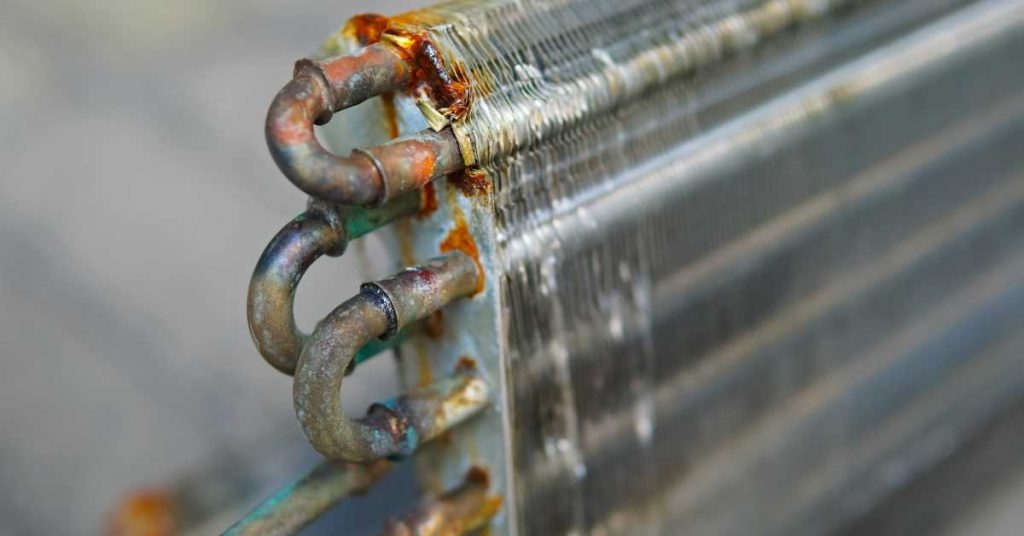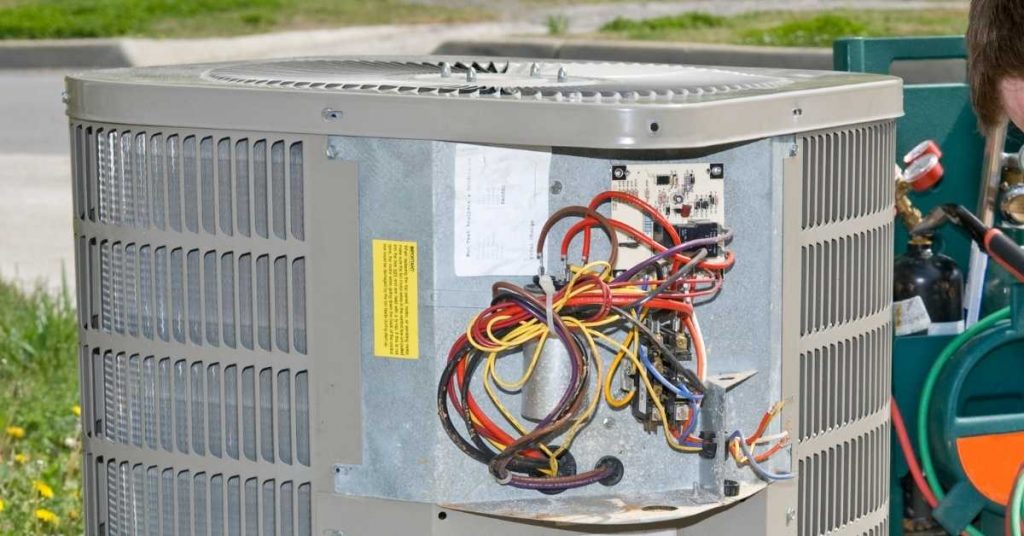
An AC condenser is a vital component of an air conditioning system that plays a crucial role in the cooling process. Here’s a summary of what an AC condenser is, its functions, types, and common failures:
What Is an AC Condenser?
- An AC condenser is an outdoor unit in an air conditioning system that works in conjunction with the indoor evaporator coil.
- It is typically a large metal box containing components such as a compressor, condenser coil, fan, and refrigerant lines.
Functions of an AC Condenser
- Heat Release: The primary function of the condenser is to release heat from the refrigerant. This occurs when the high-pressure, hot refrigerant gas from the compressor enters the condenser coil.
- Condensation: As the refrigerant releases heat, it condenses into a high-pressure liquid, undergoing a phase change.
- Airflow: A fan in the condenser unit blows outdoor air over the condenser coil, aiding in the release of heat and the condensation of the refrigerant.
- Pressurization: The compressor in the condenser unit pressurizes the refrigerant, raising its temperature and pressure to prepare it for the cooling cycle.
Types of AC Condensers:
- Air-Cooled Condenser: This is the most common type, where outdoor air is used to cool the refrigerant in the condenser coil.
- Water-Cooled Condenser: Water is used as the cooling medium in these systems, which are often employed in large commercial applications.
- Evaporative Condenser: Evaporative condensers combine air and water cooling, making them efficient in hot climates.
- Hybrid Condenser: Some condenser units use a combination of air and water cooling to improve energy efficiency.
Common AC Condenser Failures
- Refrigerant Leaks: Leaks in the refrigerant lines can cause a drop in cooling capacity and efficiency.
- Fan Problems: Issues with the condenser fan can lead to reduced heat exchange and higher operating temperatures.
- Clogged or Dirty Coils: Accumulated dirt and debris on the condenser coils can hinder heat transfer and reduce efficiency.
- Compressor Failures: Compressor malfunctions, such as overheating or mechanical failure, can result in complete system breakdown.
- Electrical Problems: Faulty electrical components, such as capacitors or relays, can disrupt the operation of the condenser unit.
- Corrosion: Exposure to weather elements can lead to corrosion and rust, compromising the condenser’s integrity.
What are the Functions of an AC Condenser?

To help you understand how an AC condenser works, let us look at the whole air conditioning process systematically.
Inside the House
As I mentioned above, the evaporator coil is found inside the house. As you can tell, evaporation is the direct opposite of condensation.
Inside the evaporator coil, the refrigerant turns from liquid to gas, while inside the condenser coil the refrigerant turns from gas to liquid. That is how both of these coils got their names.
In thermodynamics (heat transfer), heat is transferred from a point of high concentration to a point of low concentration. That is a very important principle in air conditioning.
When the refrigerant enters the evaporator coil inside the house, it is usually in its liquid state and therefore at a low temperature compared to the indoor hot air, which it intends to cool.
The evaporator coil fan pulls the hot air from the house and forces it through the evaporator coil. Just like the condenser coil, the evaporator coil contains many loops of copper tubing which increases the surface area of the refrigerant in contact with the air for maximin heat exchange.

When the hot indoor air comes in to contact with the evaporator coil, the refrigerant absorbs heat from the air which causes it to heat up. Cold air is sent back to the house while the refrigerant vaporizes and exits the evaporator coil.
Outside the House
Outside the house, the high-temperature low-pressure gas first enters the compressor. As its names suggests, a compressor is designed to compress the refrigerant and, in the process, increase its pressure.
An AC compressor is basically the engine of the system. It gives the refrigerant the kinetic energy to keep cycling through the air conditioning loop.
As I have already mentioned, heat is transferred from a point of high concentration to a point of low concentration. Although the refrigerant coming from the house contains heat from the indoor air, the air outside the house is still hot, especially during the months of summer.
And that is where the compressor becomes useful the second time. How you ask?
In gases, an increase in pressure also results in a direct increase in temperature. Therefore, as the refrigerant is being compressed in the compressor, its temperature increases as well.
The refrigerant therefore leaves the compressor and enters the condenser coil as a high-pressure superheated gas.
How an AC condenser Works
As you already know, the outside unit of the AC is quite big. Although compressors are smaller in size, condenser coils need to be large enough for proper heat exchange to take place.
The refrigerant enters the condenser coil as a superheated gas but it needs to exit as a liquid, in a process known as condensation. For that to happen, it needs to lose its heat to the surrounding.
The condenser is made up of thin tubes of copper or sometimes aluminum coils. The coil allows the unit to be compact otherwise it would be a very long tubing.
At the time of entering the condenser coil, the temperature of the refrigerant is higher than that of the surrounding air. That makes it possible for the refrigerant to lose heat to the surrounding.
A fan blows cooler air over the condenser coil which absorbs heat from the refrigerant and is then forced out of the unit. That is the reason that if you stand next to the condenser unit when it is running you can feel hot air blowing towards you.

The outside shell of the condenser unit is made up of fins similar to those of a car radiator. These fins help in the dissipation of heat to the surrounding and that is why the need to be cleaned regularly to prevent them from being blocked.
By the time the refrigerant is near the end of the coil, it will have lost a lot heat such that it will be almost in its liquid state.
The refrigerant cannot however be sent to the evaporator coil in that state since we still need the temperature to drop further. For that reason, an expansion valve is installed just before the evaporator coil.
An expansion valve is basically a restriction (a small hole). As the refrigerant passed through the expansion valve, its pressure reduces drastically.
As I had mentioned earlier, an increase in gas pressure results in an increase in temperature. The opposite also holds.
A drop in the pressure of the refrigerant also causes its temperature to fall drastically. At that point, the refrigerant is ready to enter the evaporator coil for another cooling cycle.
And basically, that is how an air conditioner condenser works.
On refrigerants, Freon (R-22) has been used for many decades but its production was banned in 2010 in favor of R-410A. More on that in this post.
Types of AC Condensers
There are 3 main types of air conditioning condensers. They are:
1. Air-Cooled Condensers
These are the condensers used for residential applications. As their name implies, these types of condensers use air to expel heat from the refrigerant.
With air-cooled condensers you can have heat exchange by natural convection or forced convection. Convection is basically heat transfer through fluids.
2. Water-Cooled Condensers
Water-cooled condensers work just like air-cooled condensers only that heat is removed from the refrigerant by water. These condensers can be categorized into 3 groups:
- Double tube condensers
- Shell and tube condensers
- Shell and coil condensers
3. Evaporative Condensers
Evaporative condensers are a hybrid of air-cooled and water-cooled condensers. Its sump pump sprays water over the coil and simultaneously a fan blows air over the condenser.
These types of condensers are used in areas where water is scarce.
When Happens when AC Condenser Fails?

In an air conditioning system, the component that is more susceptible to failure is the compressor, more than the evaporator and condenser coils. That is because the compressor has several moving parts which are prone to wear and tear.
Also, the compressor is designed to only handle the refrigerant in its gas state. If all the refrigerant does not vaporize, or when the condenser or evaporator coils are blocked, flowback of the refrigerant can happen resulting in a damaged compressor.
But what happens when an air conditioner evaporator fails?
In most cases, when an evaporator coil is blocked, enough of the refrigerant will not flow to the evaporator coil. This will result in short-cycling.
Short-cycling is when the AC turns on and off rapidly. It does this to compensate the system due to the blockage. If not fixed, short-cycling will result in overheating of the air conditioner components (especially the compressor) resulting in premature failure.
As I mentioned above, if the condenser coil is blocked, the refrigerant can be forced back to the compressor which will ultimately damage it.
A condenser coil can also crack resulting in refrigerant leak. As I wrote in this post, refrigerants don’t have a distinct smell especially at low concentrations and are therefore hard to detect.
With a leaking refrigerant, your air conditioner will struggle to cool the house and after some time it will start blowing hot air inside the house.
Some of these problems can also be caused by other AC components and that is why I always recommend having an HVAC technician come over and troubleshoot the system and find the cause of the problem.
How Do I Know if My AC Condenser is Bad?
So, what are the warning signs/symptoms of a bad or dying air conditioner compressor? The following are the 4 main ones:
1. Reduced Cooling
When your air conditioning is no longer cooling as good as it used to, you definitely have a problem with one of the components, the condenser being one of them.
2. Short-Cycling
Short cycling as we have seen is caused by a blocked condenser coil forcing the air conditioner to cycle on and off to keep up with your house’s cooling demand.
3. Leaking Refrigerant
In high concentrations, Freon will have a slightly sweet aroma while Puron (or any other R-410A) will have an ether smell. It is however hard to tell if your condenser coil is leaking.
The signs that your refrigerant is leaking are hissing sounds from the condenser, reduction in the AC’s cooling potential and frosting on some of the unit.
4. Unusual Noises
Rattling and grinding noises should not come from an air conditioner. If you experience any of these problems, you could very well have a problematic condense, but it could be other components as well.





